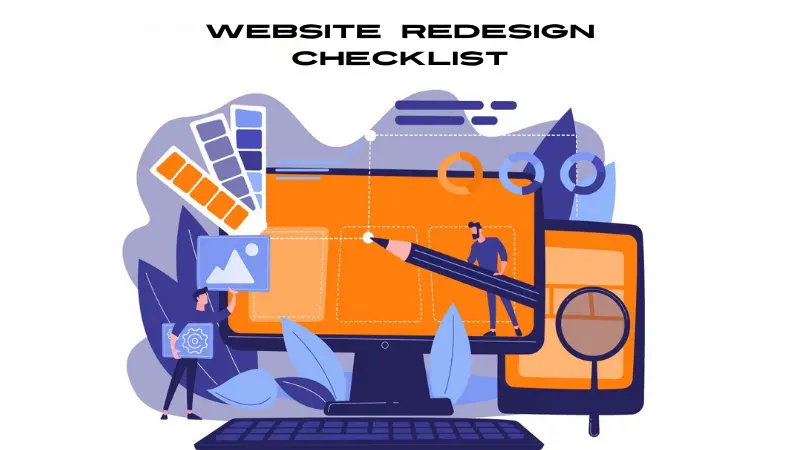A website is more than just an online presence—it is the face of your business. However, if your website looks outdated, performs poorly, or isn’t optimized for conversions, it could be hurting your brand and bottom line. A well-executed website redesign can enhance user experience, improve SEO, and increase customer engagement.
In this guide, we’ll walk you through when to consider a website redesign, how to plan it, and a complete checklist to ensure a successful upgrade.

When Should You Redesign Your Website?
Before diving into a redesign, it’s important to identify whether your website truly needs an update. Here are key signs that indicate it’s time for a refresh:
1. Your Website Looks Outdated
First impressions matter. If your website looks like it was built a decade ago, visitors may lose trust in your brand. Modern design trends focus on clean layouts, fast-loading pages, and mobile-friendly experiences.
2. Poor Mobile Experience
With over 60% of website traffic coming from mobile devices, a non-responsive website will push visitors away. Google also prioritizes mobile-friendly sites in search rankings.
3. Slow Loading Speed
If your website takes over 3 seconds to load, you lose potential customers. Google considers site speed a ranking factor, and slow websites often have higher bounce rates.
(Related: How a Fast-Loading Website Impacts SEO and User Experience)
4. Low Conversion Rates
If visitors land on your site but fail to take action (sign-ups, purchases, inquiries), your site’s design, messaging, or user flow may need improvement.
5. Your SEO Rankings Have Dropped
If your website isn’t ranking well on Google, it may be due to outdated SEO practices, slow performance, or poor content structure. A redesign can help optimize your pages for better search visibility.
(Related: WordPress SEO Tips: Boost Your Site’s Performance)
6. Difficult Website Management
If updating your website feels like a technical nightmare, switching to a more user-friendly CMS like WordPress can make ongoing maintenance easier.
Website Redesign Checklist: Step-by-Step Guide
Redesigning a website isn’t just about changing how it looks—it’s about improving performance, user experience, and conversions. Follow this step-by-step checklist for a seamless transition:
Step 1: Conduct a Website Audit
Before redesigning, assess your current website’s strengths, weaknesses, and pain points.
Review website analytics to understand visitor behavior.
Identify high-traffic pages that should be preserved.
Analyze loading speed, bounce rate, and mobile responsiveness.
Check SEO performance using tools like Google Search Console.
Step 2: Define Your Redesign Goals
Set clear objectives for your redesign:
Improve user experience and navigation.
Enhance SEO rankings and site speed.
Boost lead generation and conversions.
Align branding with your company’s latest vision.
Step 3: Research Your Audience and Competitors
Identify user pain points and design accordingly.
Analyze competitors’ websites for design trends and usability improvements.
Gather feedback from current users to understand what works and what doesn’t.
Step 4: Plan a New Site Structure & Navigation
Improve navigation for an intuitive user journey.
Use clear call-to-actions (CTAs) to guide visitors.
Reduce unnecessary pages and streamline content organization.
Step 5: Focus on SEO & Content Strategy
A website redesign should not compromise SEO. Here’s how to ensure SEO remains intact:
Conduct keyword research to optimize content.
Maintain or redirect high-ranking pages using 301 redirects.
Use an SEO-friendly URL structure.
Optimize on-page elements like meta titles, descriptions, and image alt texts.
(Related: Best WordPress Plugins for SEO and Website Optimization)
Step 6: Optimize for Speed and Mobile Responsiveness
Use a lightweight theme and optimize images.
Enable caching and use a CDN (Content Delivery Network).
Ensure the site is 100% responsive on all devices.
Step 7: Test Before Going Live
Check for broken links and missing images.
Test contact forms, checkout processes, and interactive elements.
Conduct cross-browser testing to ensure compatibility.
Step 8: Launch & Monitor Performance
Set up Google Analytics and Search Console to track performance.
Monitor user feedback and fix any post-launch issues.
Continuously test and refine the website for better performance.
FAQs
How often should you redesign your website?
Most businesses should consider a website redesign every 2-3 years to stay up-to-date with modern web standards, SEO trends, and user experience expectations.
Will redesigning my website affect SEO rankings?
A poorly planned redesign can negatively impact SEO, but following best practices—such as preserving existing content, using proper redirects, and optimizing for performance—can prevent ranking drops.
Should I use WordPress for my redesigned website?
WordPress is an excellent choice for most businesses due to its flexibility, SEO-friendliness, and ease of use.
(Related: WordPress vs Custom Websites: Which One is Right for Your Business?)
How long does a website redesign take?
Depending on the complexity, a website redesign can take anywhere from 4 weeks to 6 months.
What is the cost of a website redesign?
The cost varies based on design complexity, custom features, and whether you use a CMS like WordPress or opt for a fully custom-built solution.
Final Thoughts: Upgrade Your Website Today
Your website is a direct reflection of your brand. If it’s outdated, slow, or not driving conversions, a redesign can help you stand out in a competitive market.
Looking for a professional website redesign? Take advantage of our Free Hosting + 15 Days Free SEO (Limited Offer).
